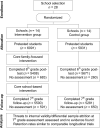Substance-use outcomes at 18 months past baseline: the PROSPER Community-University Partnership Trial
- PMID: 17478265
- PMCID: PMC2869212
- DOI: 10.1016/j.amepre.2007.01.014
Substance-use outcomes at 18 months past baseline: the PROSPER Community-University Partnership Trial
Erratum in
- Am J Prev Med. 2015 Jan;48(1):120
Abstract
Background: The study's objective was to examine the effects of "real-world," community-based implementation of universal preventive interventions selected from a menu, including effects specific to higher- and lower-risk subsamples.
Design: School districts were selected based on size and location, and then randomly assigned to a control condition or to an experimental condition in a cohort sequential design.
Setting/participants: The study included 28 public school districts in Iowa and Pennsylvania that were located in rural towns and small cities, ranging in size from 6975 to 44,510. Sixth and seventh graders in these school districts participated in the study.
Intervention: Community teams were mobilized; each team implemented one of three evidence-based, family-focused interventions (5 to 12 sessions) and one of three evidence-based school interventions (11 to 15 sessions), for 6th and 7th graders, respectively. Observations showed that interventions were implemented with fidelity.
Main outcome measures: Outcomes included student reports of past month, past year, and lifetime use of alcohol, cigarettes, marijuana, methamphetamines, ecstasy, and inhalants, as well as indices of gateway and illicit substance initiation, at pretest and at a follow-up assessment 18 months later.
Results: Intent-to-treat analyses demonstrated significant effects on substance initiation (marijuana, inhalants, methamphetamines, ecstasy, gateway index, illicit-use index), as well as past-year use of marijuana and inhalants, with positive trends for all substances measured. For three outcomes, intervention effects were stronger for higher-risk students than lower-risk students.
Conclusions: Community-based implementation of brief universal interventions designed for general populations has potential for public health impact by reducing substance use among adolescents.
Figures
References
-
- Johnston LD, O'Malley PM, Bachman JG, Schulenberg JE. Teen drug use down but progress halts among youngest teens. University of Michigan News and Information Services; Ann Arbor, MI: [02/14/06]. [On-line]. Available: www.monitoringthefuture.org;. Retrieved December 19, 2005.
-
- Mason WA, Hitchings JE, Spoth R. Emergence of delinquency and depressed mood throughout adolescence as predictors of late adolescent problem substance use. Psychol Addict Behav. In Press. - PubMed
-
- Windle M, Windle RC. Depressive symptoms and cigarette smoking among middle adolescents: Prospective associations and intrapersonal and interpersonal influences. J Consult Clin Psychol. 2001;69:215–226. - PubMed
-
- Rawson RA, Anglin MD, Ling W. Will the Methamphetamine Problem Go Away? J Addict Dis. 2002;21:5–19. - PubMed
-
- Kosterman R, Hawkins JD, Abbott RD, Hill KG, Herrenkohl TI, Catalano R. Measures of positive adult behavior and their relationship to crime and substance use. Prev Sci. 2005;6:21–33. - PubMed
Publication types
MeSH terms
Grants and funding
LinkOut - more resources
Full Text Sources
Medical
Miscellaneous


